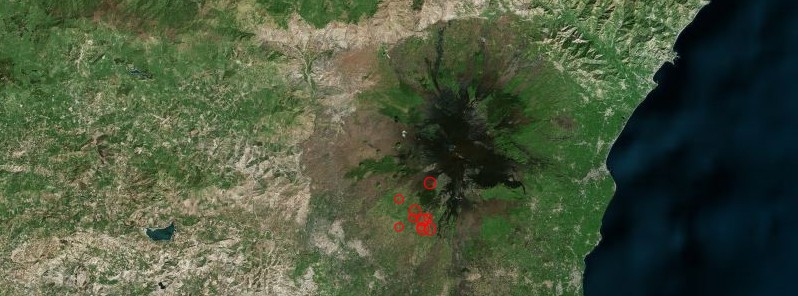Earthquake swarm detected under Etna volcano, Italy

An earthquake swarm has started under Italy's Etna volcano during the early morning hours of January 30, 2017.
The swarm is located on the volcano's southwestern slope, INGV-OE reports. The observatory added it detected about 60 shocks by 11:45 UTC, with the strongest being M3.5 at 09:51 UTC. The focal volume lies between the towns of Ragalna, M. Parmentelli and M. San Leo at a depth of 10 – 15 km depth (6.2 – 9.3 miles).
Seismic activity is ongoing but is not accompanied by abnormalities in other monitored geophysical parameters. In particular, the amplitude of volcanic tremor maintains medium-low values, typical in recent months.
Etna's New SE Crater shows no significant changes at this time. Its moderate explosive activity continues.
Read more: New eruptive activity at Italy's Etna volcano (January 26, 2017)
Geological summary
Mount Etna, towering above Catania, Sicily's second largest city, has one of the world's longest documented records of historical volcanism, dating back to 1500 BCE. Historical lava flows of basaltic composition cover much of the surface of this massive volcano, whose edifice is the highest and most voluminous in Italy. The Mongibello stratovolcano, truncated by several small calderas, was constructed during the late Pleistocene and Holocene over an older shield volcano. The most prominent morphological feature of Etna is the Valle del Bove, a 5 x 10 km (16 404 x 32 808 feet) horseshoe-shaped caldera open to the east.
Two styles of eruptive activity typically occur at Etna. Persistent explosive eruptions, sometimes with minor lava emissions, take place from one or more of the three prominent summit craters, the Central Crater, NE Crater, and SE Crater (the latter formed in 1978). Flank vents, typically with higher effusion rates, are less frequently active and originate from fissures that open progressively downward from near the summit (usually accompanied by strombolian eruptions at the upper end). Cinder cones are commonly constructed over the vents of lower-flank lava flows. Lava flows extend to the foot of the volcano on all sides and have reached the sea over a broad area on the SE flank. (GVP)
Featured image credit: EMSC

Commenting rules and guidelines
We value the thoughts and opinions of our readers and welcome healthy discussions on our website. In order to maintain a respectful and positive community, we ask that all commenters follow these rules.